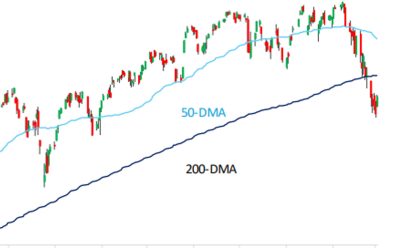Active vs. passive: Is it for real?
Active vs. passive: Is it for real?

While purely “passive” investors can theoretically earn great returns over the long term, few people achieve those returns. Human behavior inevitably derails the best intentions of many investors.
I recently read an article by behavioral finance professor Richard Lehman that focused on the active versus passive management debate. The professor’s article contains several arguments in favor of actively managed accounts that are rarely heard. While the entire article offers a good overview of the topic, I’d like to focus on his thoughts regarding the instrument most often cited in connection with implementing passive investing: the index fund.
Index funds are not made for investor mindsets
I think most of his behavioral arguments go back to a simple principle that he stated at the beginning of the article: “Even investors with the right intentions stray from a strict adherence to an index fund, thereby negating its hypothetical long-term benefit.”
This is a function of human behavior. As I have often pointed out, S&P 500 Index funds are not made for investor mindsets. Most investors will not sit still in an investment that loses more than 50%.
And if they do stay in and it returns to breakeven, they are more likely to sell on achieving that event than they are to hold on. But let’s say they do hold on at the urging of their advisors. Will they do it if it falls 50% all over again?
Yet that back-to-back 50%-loss scenario is exactly what the S&P 500 Index, and the funds and ETFs that track it, did in the decade from 2000 to 2010. In this sense, too, it is easier to understand why some of the investors who abandoned stocks in the first decade of the millennium failed to return.
And that’s why the professor contends that the results cited for the S&P 500 are not real. They are hypothetical in the sense that while they could have earned a great return over the very long term, very few investors would have received those returns. Human behavior would have caused them to abandon the investment long before the long-term yields were achieved.
The actions of the market cause investors’ behavioral tendencies to take over and result in management decisions that are contrary to their best interests. For the most part, they sell low and buy high.
‘Buy and hope’ isn’t practical advice
The index-fund industry spends millions each year telling advisers that it is their job to convince their clients to “buy and hope”—to hold on no matter what the markets do. And it is good advice. It’s just not practical advice.
Most people have learned that if you’re standing on the railroad tracks, it’s best to get off them when a train is coming. That’s learned behavior, and it’s hard to ignore it when it comes to investing—when your starting investment of $100,000 has fallen to $45,000 in an S&P 500 Index fund or $25,000 in the NASDAQ variety.
In real life, think about how hard it is to unlearn the behavior that results in smoking or overeating. When you diet, do you unlearn the behavior? Or does your weight start to creep up on you? Some people are successful at these tasks, no doubt, but most people have great difficulty unlearning behavior.
And don’t forget, advisors are human too. They have been stopping at red traffic lights their whole lives. They don’t plow through just because someone says the road is clear.
Some of the growth of passive funds is from active managers
A chief reason why people say that passive investing was winning the “active vs. passive debate” in the years following the financial crisis is that passive funds and ETFs were growing in assets while active funds were losing them. Research fielded with financial advisors shows this trend may have started to turn around in terms of attitudes following the market volatility of 2020.
In a March 2021 study conducted by The Journal of Financial Planning and the Financial Planning Association (FPA), 74% of advisors said they had reevaluated the asset allocation they typically recommend or implement within the prior three-month period. This was largely driven by concerns about the state of the economy and/or market volatility experienced over the prior year. The study concluded, “The majority of advisers (58 percent) continue to favor a blend of active and passive management, as has been the trend for the past several years. However, the 2021 results show a continued decline in a purely passive approach.”
Importantly, the typical argument around the growth of passive funds and ETFs ignores the fact that passive funds are the vehicles used by active money managers. It’s difficult to separate the active buying from a true passive investor’s buying.
The active advisor, often using strategies offered by a third-party active investment manager, does the buying and selling of the index funds to achieve the returns that are more suitable to the risk profile of their clients. Some do this by investing in a number of passive indexes and hoping diversification and occasional tweaking will save their clients, even though this method has fallen short when the indexes crashed 50% or more.
More and more advisors are using passive index funds in strategies that are dynamically managed to mitigate the risk of their clients’ portfolios. They adjust the risk of investor portfolios to help overcome human behavioral tendencies. Flexible Plan Investments has been doing this for more than 40 years, using tested, computerized trading plans to seek to eliminate the subjective while supplying the discipline to stay on a risk-management “diet.”
As the professor concludes, “Risk tolerance and the desire for control are not constants among the investing populace, and behavioral studies also show that they vary with age, wealth, and life circumstances, not to mention the market environment. Many investors need tailored, flexible strategies that can dial the risk level up or down according to the variables mentioned [in the article], getting more defensive or aggressive as conditions warrant. In most cases, active managers can supply these strategies better than the individuals themselves.”
The opinions expressed in this article are those of the author and the sources cited and do not necessarily represent the views of Proactive Advisor Magazine. This material is presented for educational purposes only.
 Jerry C. Wagner, founder and president of Flexible Plan Investments, Ltd. (FPI), is a leader in the active investment management industry. Since 1981, FPI has focused on preserving and growing capital through a robust active investment approach combined with risk management. FPI is a turnkey asset management program (TAMP), which means advisors can access and combine many risk-managed strategies within a single account. FPI's fee-based separately managed accounts can provide diversified portfolios of actively managed strategies within equity, debt, and alternative asset classes on an array of different platforms. flexibleplan.com
Jerry C. Wagner, founder and president of Flexible Plan Investments, Ltd. (FPI), is a leader in the active investment management industry. Since 1981, FPI has focused on preserving and growing capital through a robust active investment approach combined with risk management. FPI is a turnkey asset management program (TAMP), which means advisors can access and combine many risk-managed strategies within a single account. FPI's fee-based separately managed accounts can provide diversified portfolios of actively managed strategies within equity, debt, and alternative asset classes on an array of different platforms. flexibleplan.com
RECENT POSTS








